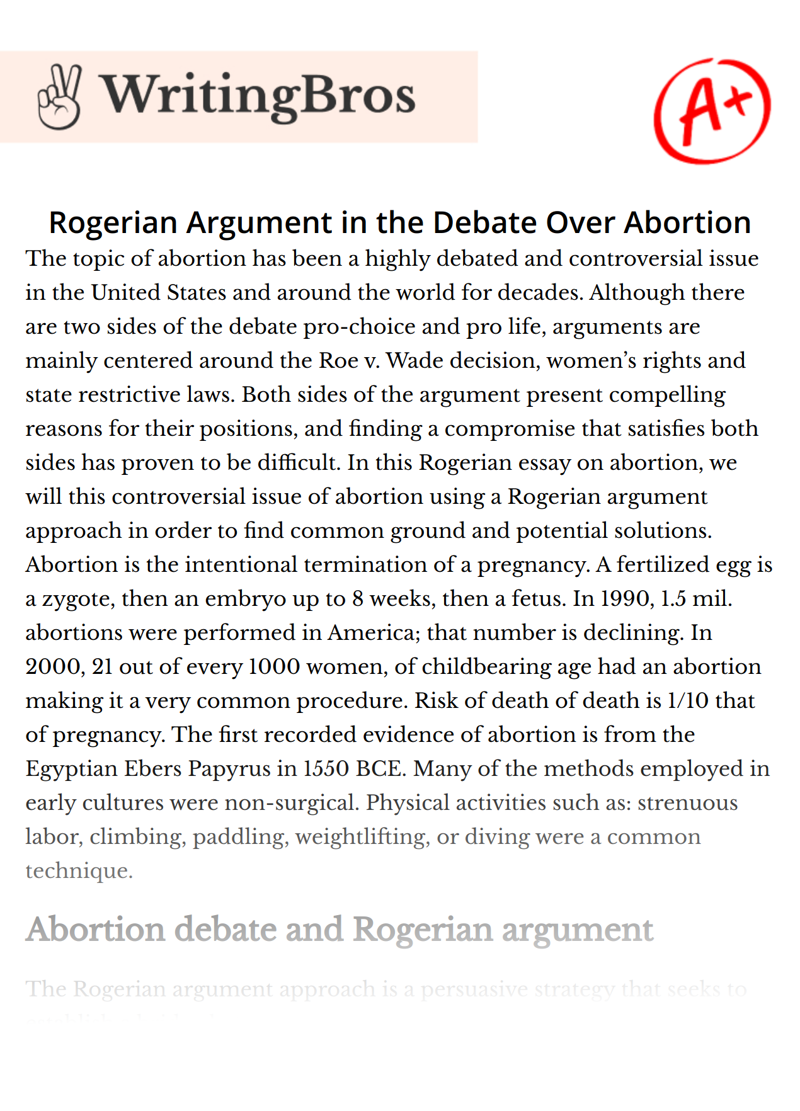Rogerian Argument in the Debate Over Abortion

The topic of abortion has been a highly debated and controversial issue in the United States and around the world for decades. Although there are two sides of the debate pro-choice and pro life, arguments are mainly centered around the Roe v. Wade decision, women’s rights and state restrictive laws. Both sides of the argument present compelling reasons for their positions, and finding a compromise that satisfies both sides has proven to be difficult. In this Rogerian essay on abortion, we will this controversial issue of abortion using a Rogerian argument approach in order to find common ground and potential solutions.
Abortion is the intentional termination of a pregnancy. A fertilized egg is a zygote, then an embryo up to 8 weeks, then a fetus. In 1990, 1.5 mil. abortions were performed in America; that number is declining. In 2000, 21 out of every 1000 women, of childbearing age had an abortion making it a very common procedure. Risk of death of death is 1/10 that of pregnancy. The first recorded evidence of abortion is from the Egyptian Ebers Papyrus in 1550 BCE. Many of the methods employed in early cultures were non-surgical. Physical activities such as: strenuous labor, climbing, paddling, weightlifting, or diving were a common technique.
Abortion debate and Rogerian argument
The Rogerian argument approach is a persuasive strategy that seeks to establish a bridge between two opposing views by acknowledging the validity of each position. In the case of abortion, supporters of abortion rights argue that women have the right to make their own reproductive choices without interference from the government or outside parties. On the other hand, opponents of abortion believe that the fetus is a human being with the right to life, and that abortion is morally wrong.
One way to find common ground between these two opposing views is to recognize that both sides are concerned with the well-being of women. Proponents of abortion rights want to ensure that women have access to safe and legal abortion services, while opponents of abortion want to protect the rights of the unborn child. By acknowledging this common concern, we can begin to explore potential solutions that address both sides of the issue.
One possible solution is to provide more comprehensive sex education and access to contraception. This solution acknowledges the concerns of abortion opponents while respecting the rights of women to make their own reproductive choices. By increasing education on safe sex practices and increasing access to contraception, we may be able to reduce unintended pregnancies, which could lead to fewer abortions.
Another solution is to provide more support for pregnant women and new mothers. This solution acknowledges that many women may consider abortion because they feel financially or emotionally unprepared to raise a child. By providing more support in the form of financial assistance, job training, and counseling, we can potentially reduce the number of women who feel they have no other choice but to have an abortion.
It is important to note that while these solutions may be effective, they are not without their drawbacks. Comprehensive sex education and access to contraception may be controversial for some, and providing more support for pregnant women and new mothers could be costly. However, by acknowledging these concerns and exploring potential solutions that address both sides of the issue, we can potentially find a compromise that satisfies both proponents of abortion rights and opponents of abortion.
In conclusion, the issue of abortion is complex and highly controversial, but by using a Rogerian argument approach on abortion, we can explore potential solutions that address both sides of the issue. By recognizing the concerns of both sides, we can potentially find common ground and solutions that respect the rights of women to make their own reproductive choices while also protecting the rights of the unborn child. While no solution is perfect, we can work towards finding a compromise that satisfies both sides of the issue.
References
- Garrow, D. J. (2018). Abortion and the Constitution: The Need for a New, Pragmatic Approach. The Yale Law Journal Forum, 128, 300-317.
- Guttmacher Institute. (2021). State policies in brief: An overview of abortion laws.
- Joffe, C. (2015). The regulation of abortion: Worldwide, strategies and trends. Journal of Public Health Policy, 36(3), 396-409.
- Lawrence, R. E. (2016). Beyond Pro-Choice Versus Pro-Life: Women of Color and Reproductive Justice. New England Journal of Medicine, 375(5), 405-407.
- Wicclair, M. R. (2019). In Defense of Abortion Rights: A Non-Religious Case against the Pro-Life Position. Oxford University Press
Cite this Essay
To export a reference to this article please select a referencing style below

